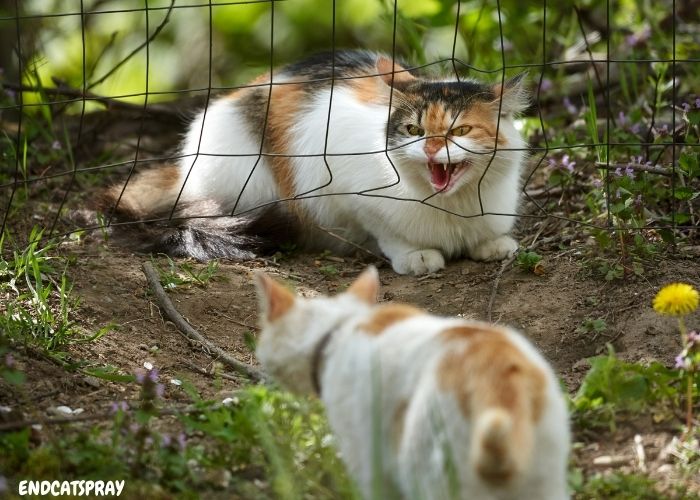A cat is the ruler of its place. Wherever they live, whether it is your house or the backyard, they like to be in control of that place. The place where they rule is their territory. Being in control of a place and having a sense of safety is their need, which is why they don’t like it when another animal enters their territory.
- Cats are naturally territorial, marking and guarding their space to feel secure, often triggered by new pets or changes.
- Cats divide their territory into zones like core, hunting, and exploration areas, showcasing behaviors like marking, patrolling, and aggression.
- Spaying/neutering, separate resources, and extra love and attention can help to reduce territorial behavior effectively.
A territorial cat might scratch at places or spray its urine on a surface to mark its territory. Don’t lose hope if your cat displays territorial behavior. This article will guide you about why your cat behaves in that manner and how to change that behavior.
Why are Cats Territorial?
Cats are instinctually territorial animals. They choose a certain spot or area as their own and mark their territory. They may get very hostile while protecting their territory from outsiders, including other cats, animals and even humans.
Being territorial is a trait that may vary between individual cats; not all of them display that kind of behavior.
Cats mostly show territorial behavior when they had not gotten a chance to socialize much during childhood or due to hormones in non-neutered cats.
Types of Cat Territory:
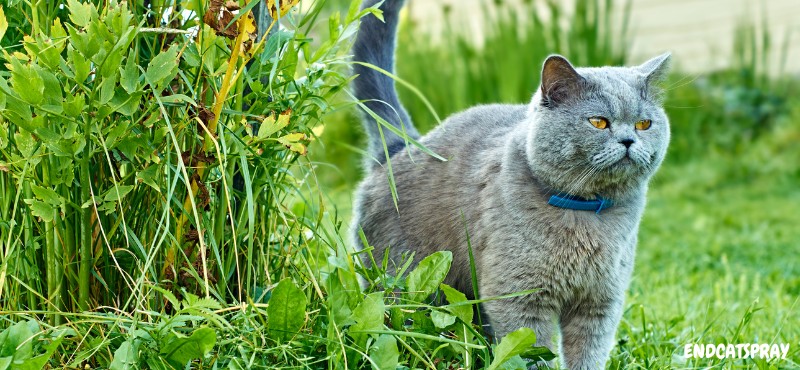
Cats are much systemized in the way they divide their territory. They have different zones as per their needs. Just as humans have separate rooms for each need in their house, like eating, sleeping and others. Similarly, cats distribute their territory for each need. Have a look at the types of cat territories:
Core Territory:
This is the most essential territory for the cats. You could call it their safe house or refuge. This is where they are the most comfortable and feel secure. It can be their resting spot, an area near their food or a bed. This zone brings them a sense of safety and relaxation.
Hunting Territory:
This zone is where cats get the opportunity to practice their innate hunting skills. The indoor pet cats get to do that by chasing toys, following shadows and jumping at objects. Outdoor cats, on the other hand, practice these skills by trailing and hunting preys such as small animals and birds. So this territory helps them satisfy their natural need to hunt and play.
Exploration territory:
Cats are very curious beings. This territory lets them explore new places. In case it’s a cupboard or something outside the house. Cats have a natural need to investigate and explore a new area or develop familiarity. It makes them feel mentally stirred and dominant of their surroundings.
Shared Territory:
Shared territory is the area that cats are comfortable and at ease sharing with others. It can be other cats, animals and humans. Although they are independent creatures, they still enjoy a sense of community and belonging and having others around them.
Boundary territory:
This includes the outskirts of their territory. They keep a watchful eye for a stranger or something unfamiliar. Indoor cats guard their territory by using areas like bushes and fences. Your indoor cat might watch landmarks such as windows and doorways. By doing so, they display their dominance and protect their territory from intruders.
Every single one of the territories mentioned above is vital in giving the cat a sense of comfort and security it needs.
What are the signs of a territorial cat?
A territorial cat will exhibit specific behavior that will convey to others that it feels like its space is jeopardized and it wants to protect its boundary. Here are a few common signs you might notice:
Marking behavior:

Cats leave their scent to mark their territory. They might do so by rubbing themselves against objects and even people. In severe cases, the cat will spray urine on vertical surfaces despite being litter box trained.
Patrolling:
Territorial cats guard their personal space by walking along the outskirts of their ‘domain’. They do so as they need to make sure that their area is secure.
Aggression towards others:
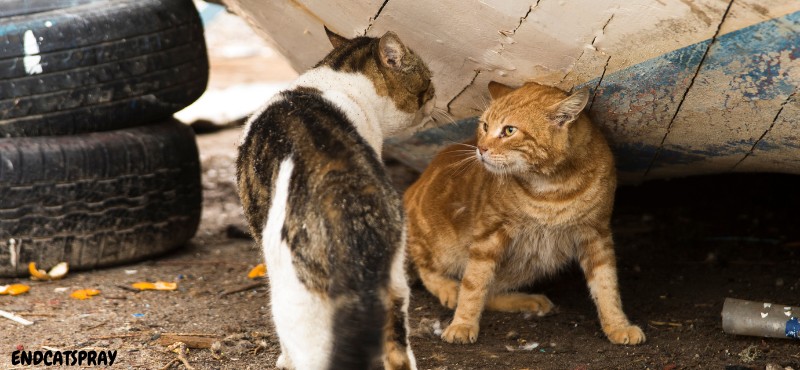
If a territorial cat feels like its boundary is being invaded, it will act aggressively by hissing, whacking, growling and in extreme cases, even attacking.
Scratching:
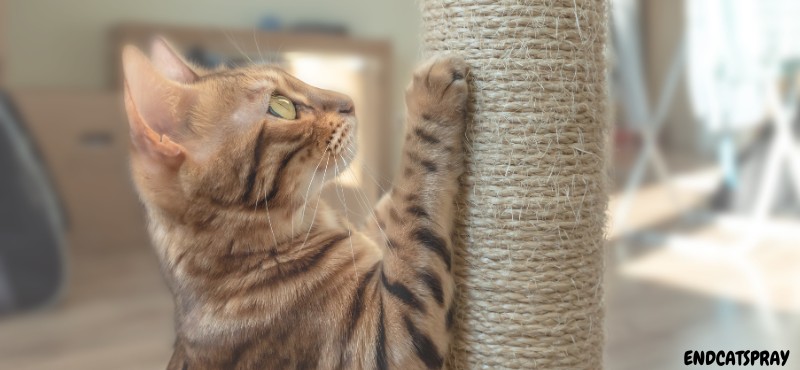
Territorial cats mark their territory by scratching at objects like furniture and carpets. By doing so, they leave being their scent through the glands in their paws.
Excessive Vocalizing:
It is very common that cats become more vocal, as in, they might meow, yor chirp loudly when they feel their territory is endangered. They might react this way when they see another cat or a new animal in their home.
Body Language:
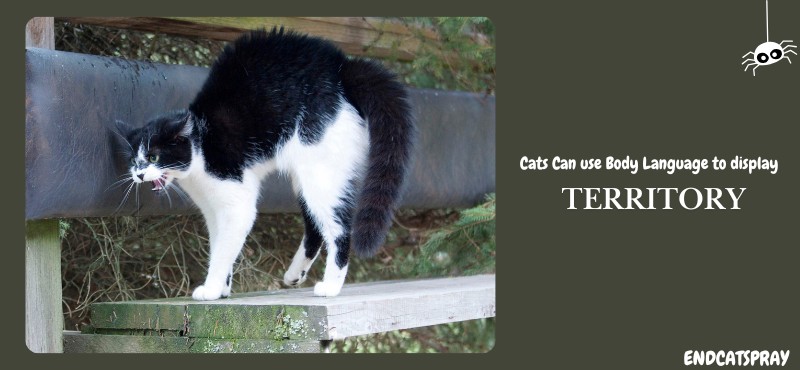
By their body language, cats show their territorial behavior. When they feel threatened, their posture becomes stiff, they flatten their ears against their heads, and ach their backs.
What causes a Cat to become Territorial?
There are various reasons as to why a cat can become territorial. All of those will be discussed thoroughly point by point.
Majorly, cats become territorial owing to their natural instincts, and need for safety. Other factors such as competing for food, having a new pet in the house, changes in surrounding and stress can also be cause of territorial behavior. It is more common among unneutered cats to react in a defensive way to protect their territory, due to their hormones. Certain negative experiences in the past, aging or a health issue can bring up such behavior in a cat. That is a cat’s way of getting a sense of security and ownership.
When do Cats start marking their Territory?
Cats start marking their territory approximately at the age of five to six months; that is when they become sexually mature. Around this time, you will notice that your cat might be spraying urine, which is brought forward by hormonal changes.
The point in life when the marking begins can vary from one cat to another, depending on its environment. The presence of another animal, changes in environment and stress are significant causes of marking territory, and that can happen at any age.
Do male cats mark their territory?
Yes, it’s true that male cats mark their territory way more than female cats do. It is more common among unneutered cats. It is in their instincts to do so in order to define and protect their boundary, engage with other cats and attract possible mates.
Do female cats mark their territory?
Yes, they do mark their territory, but not as often as males do, and the intensity is lesser too. They mark territory for the same reasons such as protecting their area, resources and sometimes, possible litter.
Is territorial behavior more common in certain breeds?
Yes, territorial behavior is more noticeable in some breeds such as Siamese cat, Bengal cat, Maine Coons, Abyssinians, and Persians. These cats are notorious for being independent, firm and very active.
Providing a pet with ample resources, opportunity to socialize and neutering can minimize territorial behavior in any breed.
What are the cat territorial size?
There are a number of factors that determine the size of a cat’s territory, such as the cat’s gender, whether it is wild or domesticated, the availability of resources and how populated the cat’s locality is. Let’s have a look at both kinds:
Wild or feral cats:
- Male cats: in the wild, male cats have a larger territory than female cats, ranging from 1 to 5 miles (1.6 to 8km). Their boundaries often connect with multiple female territories, especially during mating season.
- Female cats: females have relatively smaller territories, ranging between 0.5 to 1 mile (0.8 to 1.6km). their focus is on areas that have consistent food source and a secure place for raising young ones.
Domestic Cats:
- Indoor cats: For exclusively indoor cats, their territory is only limited to the size of the home. They still have chosen areas for eating, sleeping, playing and looking at the outside world. The size of the territory cannot be defined as it is dependent on the living space available.
- Indoor-outdoor cats: Indoor cats, that are allowed access to the outside world too, claim territory around their home too. It can range from numerous houses to a few blocks. Male cats tend to wander farther than females, depending on resources available and local cat density.
Are cats territorial over their homes?
Yes, cats are quite territorial over their homes. They depend on the comfortable environment of the home to feel secure. If due to any reason, such as a new pet or visitors, a cat feels disturbed, it can bring about territorial behavior.
Undomesticated cats protect their territory to ensure availability of resources. In a house with multiple pets, or in a neighborhood with pets, cats hold on to this extinct to ensure survival.
Do cats Mark their territory on human?
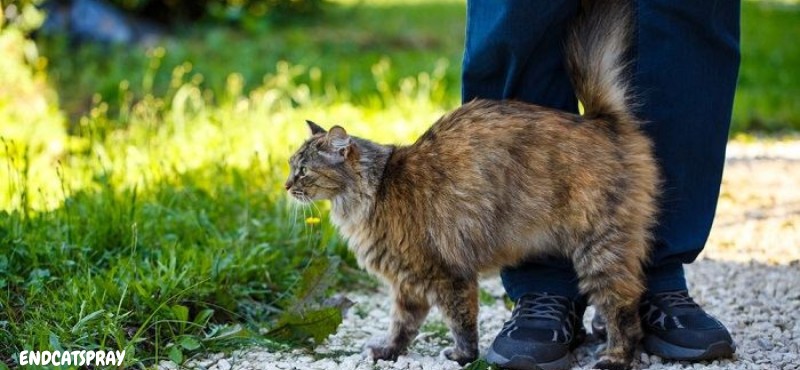
Yes, a cat may mark their territory on humans to express love. They may rub their face against their owner to leave their smell. They also knead their paws on you, which is another way of showing love.
In exceptional cases, a stressed or unneutered cat may spray urine on its owner to mark territory. If a cat feels like its bond with you is not strong, it may do so.
How to fix territorial aggression in cats?
My personal experience has taught me that giving your cat love and attention works like a charm in minimizing territorial behavior. There was a time when my cat used to spray urine all around the house and it gave a very pungent smell. Once I started giving it my utmost attention, the territorial behavior remarkably reduced.
So if you are going through the same problem, make a conscious effort to give your cat your maximum attention, and you’ll notice the difference.
Pet owners must also make sure to provide sufficient resources, like separate food and water bowl, litter and sleeping area. Creating safe zones will minimize the competition between pets and your cat can comfortably lay back and feel safe.
Getting your cat sprayed or neutered is a fruitful way of reducing or putting an ending to territorial behavior. Through a surgical procedure, the hormones responsible for causing aggression are removed.
A neutered cat no longer feels the urge to fight over territory or spray urine. In fact, it becomes calmer and is observed to be living peacefully with other pets too.
If you plan to adopt another pet and bring it to your home where there is already a pet, make sure the instruction between pets is gradual. Make arrangement for ample toys, playtime and scratch post so that your pets are mentally occupied and physically charged.
Is It Possible To Train A Cat To Accept New Additions To The Household Without Territorial Issues?
Yes, it is likely to train a cat to accept new additions to the household without territorial behavior, but one needs to be patient. The introduction has to be gradual and a secure atmosphere has to be maintained. Initially, you will have to keep the new cat in a separate area and let your cat adjust to its scent. Also make sure to provide each pet with individual resources so they don’t feel like they need to compete with one another.
Conclusion of Territorial Cat Behavior :
To sum it up, territorial behavior is a natural part of a cat’s life. If managed appropriately, you can reduce its negative impact in your life. Try your best to provide your pets with sufficient resources, a secure environment, plenty of stimulating activities to keep them occupied. Ensure that the introduction with a new pet is gradual.
Above all, give your cat the attention and care it wants and you’ll the territorial behavior significantly reduced.
FAQS:
Do all cats mark their territory?
No, not all cats mark their territory. Marking territory is dependent on multiple factors such as a cat’s age, gender, environment and reproductive status.
Male: It is most common among unneutered male cats to mark their territory by spraying urine.
Female: Unneutered female cats mostly spray urine specially when they are in heat, but that is part of their mating practice.
Stressed Cats: Cats in stressful situations, like having new pets, stray cats nearby, or big changes at home, are more likely to mark.
Dominant Cats: In homes with multiple cats, the dominant one may mark to show control and set boundaries over shared spaces.
Why are my cats suddenly fighting with each other?
There is a chance that one of the pets witnessed a stressful situation such as seeing another stray cat or was alarmed by a sudden noise. Then that cat transmitted its aggression towards the other cat. Even if there was no rivalry between them previously, it can give rise to a sudden fight.
Do indoor cats get territorial?
Yes, indoor cats can be territorial, as their instincts drive them to claim and protect their space. They often mark favorite areas by rubbing or scratching, guard resources like food or litter boxes, and may show defensive behavior toward other pets.
Resources:
